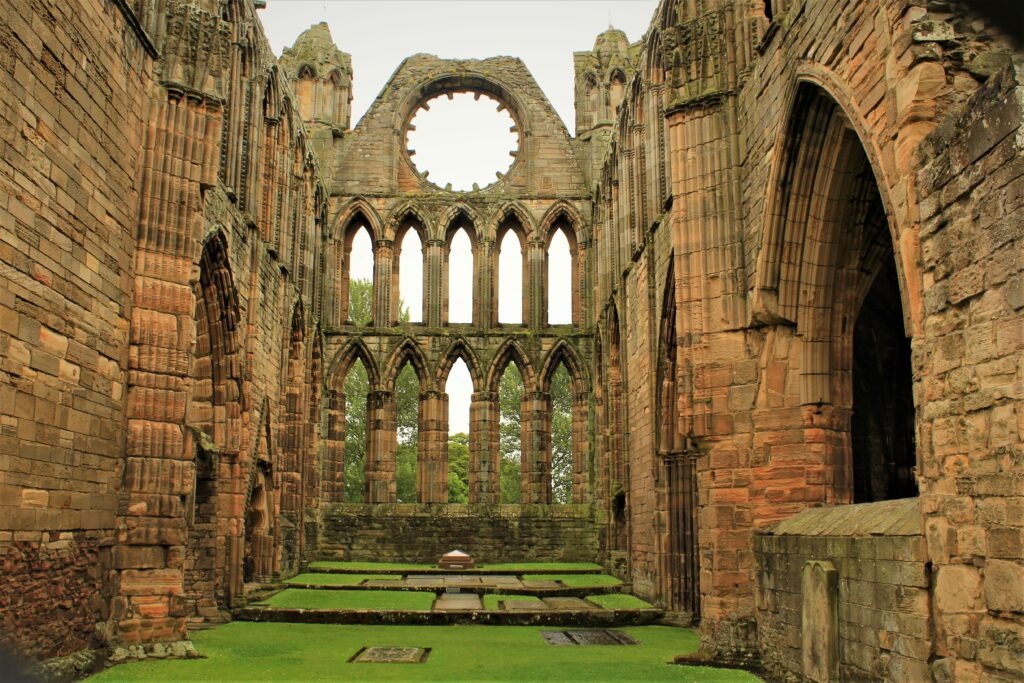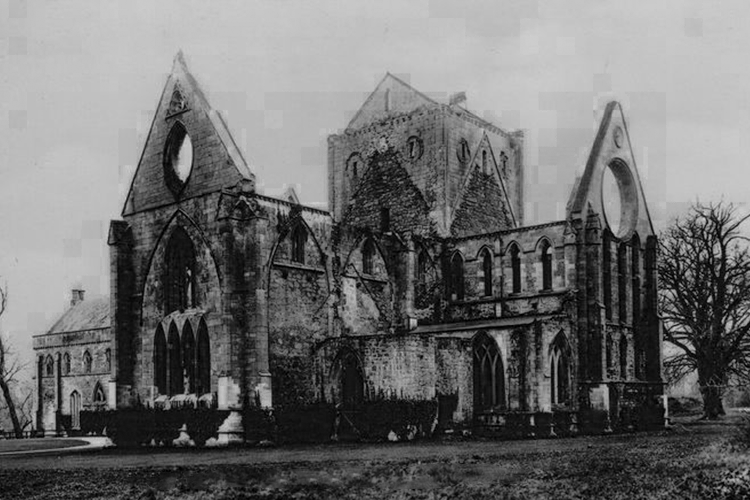
Moray Speyside is home to many beautiful churches and religious buildings with intriguing stories.
From stunning coastal churches and religious sites like the Parish Church in Findochty which overlooks the fishing village, to the imposing Elgin Cathedral as you move inland to the capital of Moray.



Here are six religious sites to kick off your ecclesiastical exploration of Moray Speyside.
Elgin Cathedral – The Lantern of the North
Elgin Cathedral‘s history is far from trouble-free… Burned down in 1390 by the Wolf of Badenoch, it lost its central tower to collapse (twice), and its choir roof blew down in a gale in 1637. Most of the Cathedral’s contents were subsequently robbed, and the rood screen was destroyed to provide firewood. But the cathedral’s fortunes turned around in the early eighteen hundreds, when John Shanks, a local ‘drouthy’ cobbler was appointed keeper of the cathedral and set about single-handedly clearing the collapsed masonry and stabilising the ruin.
There is still plenty for modern visitors to admire within the site: including the building’s impressive west front, the intact chapter house, and the north-west tower, which you can climb up to get a great view. There are also tombs, gravestones and statues to look at – including one dedicated John Shanks, the drouthy cobbler who worked so hard to restore the cathedral in the 19th century.


- Marvel at the wonderful 13th-century west front, one of the finest architectural achievements in Scotland
- Stand by the stone bishop in the nave, a larger-than-life statue that looks like a giant chess piece
- Step inside the octagonal chapter house, where the cathedral clergy met, to see its stone carvings of beasts and faces
- Seek out Scotland’s tallest gravestone – placed against the south choir aisle, for the Anderson family, it stands 5m high
- View a rare image of Pictish falconry on the Pictish cross slab, found on the site of St Giles Parish Church
- Study the cathedral’s carved stones in a new exhibition in the cathedral towers
- Explore the castle with our fun fact-finding quiz (also in Doric). You can also try our sculptures and symbols spotter and graveyard count quizzes.


Visit the Elgin Cathedral Website to find out more about the building, and to find opening times and prices.
Kinloss Abbey
Located just three miles outside of the historic town of Forres, Kinloss Abbey is the largest Cistercian monastery in the North of Scotland. The Abbey was founded in 1150 by David I and populated by monks from Rievaulx and Melrose as well as from Clairvaux. It became one of the largest and wealthiest monastic houses of the North, endowed by royalty and nobility with many properties and rights.
After the Reformation, the Abbey was sold in 1643 to Alexander Brodie of Lethen, who systematically (but not completely) dismantled the stonework and sold it to Oliver Cromwell to build the Citadel in Inverness.


The main free-standing structure of the Abbey is the South Transept with associated Chapel, the Sacristy with the Prior’s Chamber above. To the south and west are two near complete cloister walls one containing the Lavatorium and archway into the Refectory.
South of the Abbey (outside the cemetery) is the Abbot’s House. Currently parts of this area are unsafe and fenced off and The Kinloss Abbey Trust is focusing conservation efforts on this area soon. At ground level it is possible to see the remains of most of the foundations or low walls of the Abbey including the south wall of the church, the north Transept and many of the columns within the Nave.
Kinloss Abbey is still used as a burial ground today. Visitors are welcome all year round.
Find out about Kinloss Abbey
Pluscarden Abbey
Pluscarden Abbey is a Benedictine monastery founded in 1230 by King Alexander II. Grants were also made to two other sister houses in Beauly and Ardchattan at the same time, and the community that served these churches was one of Valliscaulians, a little-known order that shared some of the strictness of the Carthusian discipline with the spirit of fellowship that existed among the Benedictines.
In 1454, following a merger with the priory of Urquhart, Pluscarden Priory became a Benedictine House.
The Abbey suffered the inevitable burning at the hands of the incorrigible Wolf of Badenoch, whose wild depredations afflicted so many Moray establishments, in 1390. (Reference to statue in Elgin town centre)
Pluscarden is the only medieval British monastery still being used for its original purpose, the Mass and Full Divine Office being sung by the monks daily in the Abbey church in Gregorian chant.



Mass is held on a Sunday at 8am (in English) and 10am (in Latin). It is also held on weekdays at 9am.
The public are welcome to attend services. Guest accommodation is available for retreats.
Visit the Pluscarden Abbey website to find out more.
St Rufus Parish Church
Built in the early 19th century, St. Rufus was a replacement for the original medieval church of Old Keith, rebuilt in 1816. St Rufus is a large, tall, rectangular building, built in a style described by Charles McKean as “flamboyantly perpendicular and a striking west tower which rises to 36.6m in height. St Rufus is a fine example of a more or less complete and original early 19th century church interior.
The main internal doorway into the nave from the entrance lobby at the east end incorporates an unusual war memorial. The outer sides of the recessed double doors bear polished panels, listing men from the parish who died in the First World War; the inner side of the same doors bear similar, albeit smaller and less elaborate, panels recording those who died in the Second World War. The doors are surrounded by a wooded frame with recessed, traceried panels; above, there is a frieze in the form of a crenelated parapet with quatrefoil tracery At the west end of the nave is the sanctuary, behind which a very tall and grand but simply decorated pipe organ, with wood panelling and painted pipes
Find out more about St Rufus Church
Aberlour Parish Church
This church is situated in the centre of the village. It was built in the 1812 to replace the old church a short distance to the west and to provide a place of worship and focal point for the new village centre. The church has a complex history. It was extended in the 1830s and 40s and a large tower was added to the front. The nave was then destroyed by fire and subsequently rebuilt. The church had a lot of work carried out in the 1930s when dry rot was discovered. The interior was completely renovated, and new furnishings installed.


Much more recently, in the 21st century most of the interior was completely renovated, and new furnishings brought in. The east end of the church has most of its original layout and furnishings though. The chancel is accessed through a tall round masonry arch and there are two smaller round-arched recesses on either side. The northern one holds a small pipe organ, possibly dating from the 1930s re-fit. The chancel is raised up from the nave by three steps and there is a wooden communion table at the centre, which has simple recessed panels. Modern white and purple lighting adds a contemporary touch to the chancel space and helps draw the eye. There are memorial stained-glass windows in the chancel.
Find out about Aberlour Parish Church
Cullen and Deskford Church
The Old Church is ¾ of a mile from the centre of Cullen, at the original site of Cullen (the village was moved to its present position in the 1820s). The first mentions of this church were recorded back in 1236, and it is thought that part of the present building dates to then. In 1327, Queen Elizabeth de Burgh, second wife of Robert the Bruce, died at Cullen, and the king founded a chaplainry in that year to pray for her soul.
The church was dedicated to St. Mary the Virgin, who is also the patron saint of Cullen. A carving of her can still be seen ion the Old Mercat Cross in Cullen Square.


The church has two windows which are stained glass and were installed in memory of the Reverent James Mackintosh, who was the minister of Deskford, 1843 – 1902.
Find out about Cullen and Deskford Church
Holy Sites of Moray Speyside – A Religious Centre of Scotland
Moray has been one of the most important religious regions in Scotland for hundreds of years. But do you know the tales surrounding the Wizard of Gordonstoun or how Pluscarden Priory became Pluscarden Abbey?
Find out this and more in our article celebrating the Year of Scotland’s Stories.



